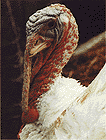



In a bid for cheap meat, chickens turkeys and ducks have been forced into the windowless sheds we now see disfiguring Britain. The photo below of a male breeding turkey illustrates the depths to which the modern poultry industry has sunk.
"The worst torture to which a battery hen is exposed is
the inability to retire somewhere for the laying act. For the
person who knows something aboutanimals if is truly
heart-rending to watch how a chicken tries again and
again to crawl beneath her fellow-cagemates to search
there in vain for cover. "
Professor Konrad Lot
Nobel prize winner and animal behaviourist.
Since Professor Lorenz made this observation (in 1981) scientists have proved that under experimental conditions, hens will overcome an amazing range of obstacles to reach the seclusion of a nesting box. For the abused battery hen there is no hope - she must lay he in a crowded cage, on the bare wire floor.
PLEASE NOTE
The Welfare of Battery Hens Regulations 1987 allow 450 cm2 of cage
floor space for each battery hen -- less than the area me area of this
page.
'For the person who knows something about animals it is truly
heart-rending to watch how a chicken tries again and again to crawl
beneath her fellow-cage-mates, to search there in vain for cover.'
When an egg is produced, the vent becomes distended, red and moist,
attracting the attention of bored and frustrated birds. Vent pecking can
occur, and even lead to cannibalism. In cages there is no escape!
(the below image shows battery hens with a collection of 'farm fresh' eggs building up behind their two dead companions)
Research at Bristol University has indicated that a massive 24% of battery
hens suffer broken bones during catching.
(Often nearly featherless,
'spent' hens suffer greatly
during transport to slaughter.
These three were spared this
fate. Here they are seen
enjoying sunshine for the
very first time. Notice how
one is spreading her wing, to
feel the sun's warm rays.
Photo: Dave Clegg)
With birds reared together in such huge nurnbers(45,000 in one shed is
typical of new units) proper welfare inspections are impossible. Many dead
and dying birds go un noticed, to decompose in the litter on the shed floor.
Heat stress is a major cause of death. Botulism has occurred in cattle fed
or bedded on used chicken litter.
In plain English, hungry broilers are getting their exercise foraging in faeces
and litter for non-existent feed!
A leading poultry scientist has suggested caging broilers (this already
happens in some parts of the world) as a 'solution' to some welfare
problems.
The modern broiler is a genetic freak, doomed to all manner of physical
and mental ills, all the result of:
Many breeding females are debeaked, to minimise damage from aggression, and this may cause life-long pain. Males are not debeaked as
they need to grasp the hen's comb when mating.
Damp and impacted litter and the barren environment, plus genetically-
induced leg weatness, lead to hock burns (similar to bedsores) and
ulcerated feet.
(Image - Inside a typical intensive turkey unit. Photo: Philip Lymbery)
MAFF estimates that around 75% of the national duck flock is kept
intensively, in broiler-type sheds, where lighting may be a I most constant,
but dim.
Fine words, but empty ones. In its ADAS Reference Book 70 'Ducks and
Geese', we are told:
Many ducklings never know anything better than a shallow drinking trough
or, worse, systems that don't allow immersion of the head. Eye problems
(even blindness) and poor feather condition can result from this deprivation. It is cruel to deny ducks water to swim in since they are genetically
'programmed' to spend most of their time in water.
A draft European document on duck welfare mentions 'the welfare
problems which currently arise' (in relation to catching and transport)-
problems no doubt similar to the cruel 'problems' seen in the chicken and
turkey industries.
THE BATTERY HEN
Battery cage conditions do nothing to destroy 'ancestral memory':
'Chickens in battery cages which have wire floors...can often be seen to
go through all the motions of having a dus-bath.. If such -dust-deprived
birds are eventually given access to something in which they can have
a real dust-bath ... they go in for a complete orgy of dust-bathing. They
do it over and over again, apparently making up for lost time ...'
Through Our Eyes Only, Dr Marian Stamp Dawkins, Department of
Zoology, Oxford University (W. H. Freeman, Spektrum 1993)
THE TRUE LIFE STORY OF THE BATTERY HEN
DayOne
Chicks are sexed at high speed, and the males killed. (Laying hens have
been genetically selected for high egg production so the males of this
strain are considered uneconornic to rear. This culling at the hatchery stage
applies to all systems, including free range.) Many 'Easter chicks' die a
slow and distressing death in the gas filled 'rubbish' bins into which they're
tossed.
Day Two to Point of Lay
The young birds are reared in special
cages, or on deep litter. Those 'lucky'
ones initially allowed their freedom
in deep litter systems suffer a cruel
shock when, at around 18 weeks,
they're imprisoned in battery cages
- for life.
Debeaking/ Beaktrimming
Some chicks are debeaked, a mutilation involving partial amputation of
the beak with a red hot blade. This is
to minimise Cannibalism in later life and can result in life-long pain.
A Year in Cages
Most battery hens spend around one year in laying cages before going for
slaughter. Some are force-moulted in readiness for a second year of incarceration. For their entire lives they stand or crouch on bare sloping wire,
often suffering severe damage to feet and claws, always enduring
discomfort and distress. Cages are stacked three, four or five tiers high
(sometimes higher) and a typical cage for five hens measures 18" by 20"
(45 by 50 cms).
The Cruelty of Cages
In their natural state hens are active from dawn to dusk, walking, running,
pecking and scratching in the ground for food, dust-bathing and nestbuilding - all behavioural patterns denied to the battery hen. Severely
frustrated, caged hens turn to pecking at each other.
The Laying Ordeal - What Price Those 'Farm Fresh' Eggs?
Today's hybrid hens lay five or six times a week. Battery hens become
highly stressed and aggressive during the prelaying period because of
lack of privacy and nesting materials. Konrad Lorenz, the renowned animal
behaviourist, wrote:Diseases of Intensification - Cages Promote Suffering
Many diseases and injuries go unnoticed in the gloomy, overcrowded
cages. Birds in the top and lowest cages suffer most from neglect, being
hard to see. Impacted eggs, prolapses and disorders of kidneys and liver
plague battery hens, and Marek's disease (a form of cancer) takes its toll.
Often, birds reach the point of death before farmers notice anything amiss.
Worse, dead hens (such as those in photo below) are left in cages for long
periods, while 'farm fresh' eggs roll past or lodge against the corpses.
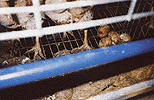
Tumours
Many spent hens have malignant tumours. In the dimly-lit cage conditions
they're ignored, and many sick birds are loaded onto lorries to travel to
slaughter. Could cancerous birds reach the consumer?
Brittle and Broken Bones
Cage conditions result in hens with bones so brittle they snap when
catchers wrench them from the cages. An ex-poultry worker gave the
following description of his daily tasks and the catching process:
'One of my jobs was removing dead birds. There was never any
shortage. Due to poor light the bottom two tiers of cages were in
darkness, and it was impossible to see if the birds were still alive.
When the carcasses were removed it was often a matter of a
skeleton head and a few bones. I once took part in the clearance of a
ten thousand bird shed. Other lads were brought in from local farms
and the torture commenced. I recall being shouted at for my
gentleness. Birds were dragged from the cages by their legs. Four
birds were carried in each hand end down, down the shed to the
door. The noise was deafening, the smell was putrid. Legs, wings
and necks were snapped without concern. As I now look back, the
whole system is incredibly cruel. After saying all this, this particular
farm was good as far as battery farms go. The floors were swept
daily and precautions taken against disease and pests ... I gave up
work in the poultry industry after bad dreams at night.'
Transport to Slaughter
Millions of battery hens travel great distances to slaughter, since only a
handful of processing plants specialise in the killing of 'spent' hens. Often
nearly featherless, they may endure journeys in near-freezing conditions,
While hot weather can cause death from heat stress.
Slaughter
Most poultry are killed by electric
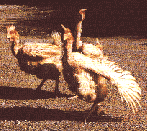 stunning plus neck cutting. UK
law requires that the birds are
rendered unconscious by the
electric stun until death occurs
through blood loss (exemptions
exist for Jewish and Muslim
methods). Research by scientists
at Bristol University found that
when an appropriate current was
used, 98% of hens ended up with
multiple broken bones. Bone splinters in spent hen meat present a problem
for the food industry. A 'solution' is to reduce the electrical current, so
fewer bones break. When this is done, battery hens may have their necks
cut and even enter the scalding tank fully conscious. Spent battery hens
are processed into soups, stock cubes, 'convenience foods' and babyfoods,
or used in the restaurant trade.
stunning plus neck cutting. UK
law requires that the birds are
rendered unconscious by the
electric stun until death occurs
through blood loss (exemptions
exist for Jewish and Muslim
methods). Research by scientists
at Bristol University found that
when an appropriate current was
used, 98% of hens ended up with
multiple broken bones. Bone splinters in spent hen meat present a problem
for the food industry. A 'solution' is to reduce the electrical current, so
fewer bones break. When this is done, battery hens may have their necks
cut and even enter the scalding tank fully conscious. Spent battery hens
are processed into soups, stock cubes, 'convenience foods' and babyfoods,
or used in the restaurant trade.
EAT-TYPE CHICKENS - OFTEN CALLED
BROILERS
The mother
hen is fiercely
protective of
her chicks,
sheltering
them under
her wings for
their first two
months of life.
Genetically
selected for
fast growth,
brolier
chickens are
saughtered when only 6 or 7 weeks old (a healthy chicken's life
span is as many years)
A Short Life and a Brutal One
Mass-produced chickens (around 99% of the market) spend their short
lives in huge windowless sheds. Motherless, the chicks must fend for
themselves from day one. Those that fail to find their way to food and
water points are called 'starve-outs'. Towards the end of the cycle, some
broilers are so crippled they cannot walk, so these too die from starvation
and dehydration.
Baby Giants
Selective breeding for 'greedy' birds, and the addition of growth-promoters to the feed, have ensured an end-product twice as heavy at seven
weeks as chickens should be - and were, before the poultry and drug
industries moved in. The result? PROFITS for producers and SUFFERING
for the sick and deformed birds.
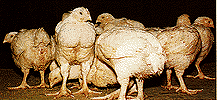
Squalid Conditions
An attempt to collect the 'deads' should be a daily task. A poultry worker
has described it as follows:
'This has to be done every day because ofthe heat and the way the
birds are packed so tight. When you pick up a dead bird it's quite
common for them to be so putrid that they are just bags of bone and
fluid.'
(Lincolnshire Free Press, 5 Oct.'87)
(Image - Six week old broiler chickens)
Diseases Old and New Take Their Toll
 Diseases (including heart attacks
and fatty liver and kidney syndromes) kill many young birds.
Now, viral diseases like Gumboro
(this destroys the immune system
- it's been called 'chicken AIDS')
and chicken anaemia agent (CAA)
are taking their toll, often pushing
mortality figures well into two
figures. (Yes, Gumboro can kill 10-
20 thousand chickens in one shed
alone!) Ascites provides another
major headache for an industry
which has produced a bird with
masses of profitable flesh, but
organs so immature they cannot
function effectively. Ascites resuits in an internal accumulation of yellow or blood-stained fluid. It's a
disease associated with
Diseases (including heart attacks
and fatty liver and kidney syndromes) kill many young birds.
Now, viral diseases like Gumboro
(this destroys the immune system
- it's been called 'chicken AIDS')
and chicken anaemia agent (CAA)
are taking their toll, often pushing
mortality figures well into two
figures. (Yes, Gumboro can kill 10-
20 thousand chickens in one shed
alone!) Ascites provides another
major headache for an industry
which has produced a bird with
masses of profitable flesh, but
organs so immature they cannot
function effectively. Ascites resuits in an internal accumulation of yellow or blood-stained fluid. It's a
disease associated with
'the high oxygen demand of rapid growth in the modern broiler,
combined with restricted space for blood flow through the capillaries
of the lung'.
(Poultry Diseases, Ed. F. T. W. Jordan, Balliere Tindall, 1990)
Painful Afflictions
Millions of broiler chickens develop painful ulcerated feet and hock burns
(these are like bed sores in humans). High ammonia levels can cause
blindness. All this suffering occurs while broilers are mere baby birds.
A Cruel End
Catching, transport and slaughter all cause trauma and pain to broilers.
Soft young bones break, and joints (often already painfully deformed)
become dislocated when birds are caught. Carried several in each hand
by teams of 'catchers' working at top
speed, they're thrown or crammed
into crates or modules (drawer-like
containers) to be loaded onto lorries.
Often, legs and wings are trapped,
and heads crushed, before the
journey to slaughter begins. 'Chicken
pieces' (those handy items so popular
at buffets, barbecues etc.) may have
been salvaged from injured or sick
birds, having previously borne a
terrible weight of suffering in the
gloom of a filthy broiler shed. As with
 spent hen slaughter, a 'humane' kill
is never guaranteed, and it's been
suggested by poultry researchers that
many chickens are inadequately stunned, and feel the pain of neck cutting.
Again, some enter the scalding tank
alive, perhaps conscious.
spent hen slaughter, a 'humane' kill
is never guaranteed, and it's been
suggested by poultry researchers that
many chickens are inadequately stunned, and feel the pain of neck cutting.
Again, some enter the scalding tank
alive, perhaps conscious.
(Image - Chickens with ulcerated feet sold
for human consumption.
Photo: Chickens' Lib)
Future Deprivations?
A disturbing picture is emerging of
novel ways of papering over the
cracks' of the disastrous broiler industry. Feed restriction for the Young birds is being recommended as a
way of minimising diseases associated with unnaturally rapid growth and
poor environmental conditions:
'With controlled feeding of broilers becoming a growing trend it is
important to sell it as a welfare friendly management style to the
general public. This means getting the right message across which
is "controlling growth" not "restricting feed" ... there is obvious
potential in controlling the growth of broilers, but it needs the right
terminology.'
(John Farrant, Editor, Poultry World, November 1994)
The poor health status of the modern meat-type chicken is 'man-made'
and amounts to cruelty, knowingly inflicted in the name of economics
and profit.
Broiler Breeders - the parent Stock
Hidden well away, and generally forgotten, are the millions of breeders
Supplying semen and eggs for the chicken meat industry. Kept in broiler
Sheds in their hundreds or thousands, their lives are stressful, especially
For the hens, when frequent matings result in severe feather wear. Ammonia levels in the sheds may be very high, causing blindness.
Feed Restriction
Feed is severely restricted. Broilers have been specifically bred for
'greediness' as this suits the broiler industry for those birds killed at 6-7
weeks. But if breeders were fed ad lib they'd suffer from disastrously low
fertility and high mortality in later life. To 'solve' this problem they are
kept on minimal rations that leave them so hungry they peck at empty
troughs and the shed walls, eat faeces and litter, and drink large quantities
of water in a futile attempt to assuage their appetites. Since excessive
drinking produces wet droppings (then soggy litter) the water supply may
be restricted too. This regime lasts for their first few months of life. In its
'Breeder Management Guide' (revised 1994) one of the world's major
broiler breeding companies, the Cobb Breeding Company, advises two
alternative feeding programmes for this period: "Skip-a-Day" and 'Five Days/Week Feeding'. The first involves no food at all every other day but double
(though meagre) rations when it is given, and the second method increases
the daily recommended amount somewhat but omits all food three days
out of eight. By any norma I reckoning, such treatment is cruel and should
be prohibited. Even when the degree of feed restriction is less extreme
(after week 20) breeders are kept very hungry, to ensure maximum fertility/profitability. The pronounced head shaking sometimes seen among female
breeders is probably caused by the stress of constant hunger and
unnaturally frequent mating.
Worn-Out Breeders Into Canned Soups
At the end of their peak semen and egg producing days, broiler breeders
are slaughtered and processed into pies, soups etc. Many are culled during
the breeding cycle, since only the most productive birds are kept.
 (Image - Only a few weeks
old - victims of the
modern broiler
system.
Photo: Chris James)
(Image - Only a few weeks
old - victims of the
modern broiler
system.
Photo: Chris James)Turkeys
Turkeys are highly individual
birds. The females are as
maternal as any mother hen.
The males (stags) fluff up their
fine feathers and 'gobble', to
establish their role as
protector of the harem. The
wild turkey flies at speeds of
up to 50 mph and roosts in
tree tops. Stags weigh around
77 Ibs, females considerably
less. Turkeys like to roam in
woodland, eating insects and
vegetation. Seeds and berries
are a favourite food..
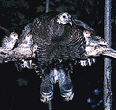 (Mother turkey protecting her
young. Photo: Gary W. Griffen
copyright Animals Animals/OSF)
(Mother turkey protecting her
young. Photo: Gary W. Griffen
copyright Animals Animals/OSF)
Today's Turkey - Designed to Suffer
Turkey meat is available all year round and comes in many guises. It's
often promoted as a healthy food. The modern geneticaliy-selected bird
bears little resemblance to its wild counterpart, especially the male of the
species, who can now scarcely lift his feet off the ground.
The Ugly Truth
Most turkeys live crammed together in dimly-lit windowless sheds. 15,000
in one shed is typical of the bigger units. Though not caged, turkeys nearing
slaughter weight have little more floor space to themselves than a battery
hen. Moving around the shed becomes a stressful challenge and the
overcrowding induces aggression. Some, reared especially for the
Christmas trade, are kept in 'pole barns', in natural daylight. These may
have a little more room, but are still kept in grossly overcrowded conditions.
Cannibalism
Turkeys become aggressive when stressed, and attack each others' eyes
and toes. The Ministry of Agricultu re (MAFF) estimates that 20% of turkeys
are debeaked. The mutilation is carried out with a red-hot blade, and can
result in permanent pain. Most 'pale barn' turkeys are debeaked, since
aggression is rife when birds can see each other clearly. In general,
outbreaks of cannibalism are kept to an 'acceptable' level either by
debeaking or by keeping hirds in semi-darkness.
Starveouts
Young turkeys are well-known for failing to find food and water points.
Since all modern turkeys begin life with no maternal care, many die from
starvation and dehydration at an early age.
Diseases
Sudden death (caused by lung congestion, and a condition similar to
dropsy) is an important cause of mortality, especially in fast-growing male
birds. Other major killers include turkey rhinotracheitis (TRT) and
colisepticaemia, necessitating the frequent use of antibiotics.
Environmental Damage
Broilers and turkeys suffer in a similar way.'Ammonia blindness' can occur
when litter condition is poor, in the overcrowded, badly ventilated sheds,
damaging the eye's surface. Birds suffering from ammonia blindness hide
away in dark corners, rubbing their eyes with their wings, giving cries of
pain.

The Parent Stock - Victims of Cruel Exploitation
Modern turkey breeding is artificial. Male turkeys have been bred to be
unnaturally heavy and 'meaty'. Today's adult male turkey can weigh around
80 Ibs (36 kg) - over four times as much as its wild cousin. Most tip the
scales at 50-60 Ibs, but are still far too heavy and broad-breasted to mate
with the smaller female. Artificial insemination (AI) is now virtually 100%
throughout the turkey industry.
The Trauma of AI
Every few days the males are caught and 'milked' by teams of AI operaters,
who manually stimulate the area of the male sex organ. When the phallus
protrudes, it's possible to squeeze out semen, which is then sucked up a
tube to be stored. Bruising of the male genital region occurs if too many
'strokes' are administered or if undue pressure is exerted on the abdomen.
Once the females have been 'opened up', semen is injected into their
vaginas, either via a hypodermic syringe, or by means of a length of tubing
through which the operater blows. The insemination is carried out at high
speed - MAFF's reference book 242 'Turkey Breeding and Husbandry'
estimates about half a minute per bird. The procedure is so traumatic that
MAFF advises it should take place 'in the cool of the day' in warm weather,
to minimise heat stress.
Broodiness - Maternal Instincts Persist
Upto 700io of female breeding turkeys become broody, wishing to incubate
and hatch the eggs they've laid, and this despite the best efforts of the
industry to discourage an unprofitable habit. It's been estimated that around
50% of labour costs are spent on the stockperson's job of attempting to
prevent and disrupt broodiness. 'Remedies' for broodiness include frequent
egg collection and ejecting birds from nests. Drugs to counteract
broodiness have been investigated.
Welfare Insults
Many breeding turkeys are debeaked, to minimise aggression and
cannibalism. Males are often de-snooded, and are thus deprived of a
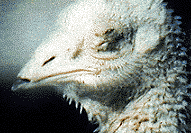 (Image - Debeaked turkey
with damaged eye.
Photo: Oxford) Environmental Films
(Image - Debeaked turkey
with damaged eye.
Photo: Oxford) Environmental Films
sensitive and expres-
sive organ. As can be
seen from this photo,
debeaking a flock pro-
vides no gua ra ntee that
severe damage will not
be inflicted by fellow
birds.
Diseases in Breeders
Males suffer especially, because of relentless selective breeding for a heavy
bird. Diseases of the hip joints are extremely common, and painful. A
leading British poultry researcher has claimed that virtually all male
breeders of the heaviest strains are reluctant to walk.
High Rate of Culls
As with broilers, only the most productive are kept for a full year's breeding,
and culling is common. And like broilers, once their year spent as semen
and egg machines is over, turkey breeders are processed into pies,
sausages. etc.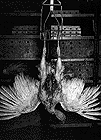
Catching, Transport and Slaughter
Turkeys are large, strong and easily frightened. Violent treatment of birds
occurs when catchers move in to grab the terrified birds by the legs. They're
then forced into crates or modules so roughly that a major cause of
downgrading at the slaughterhouse is bruising. Inevitably, some die en
route to the processing plant.
Turkeys are killed in the
same way as chickens.
They suffer greatly at
sla ug hter. Very heavy, at
male adult can weigh as
much as an 8-9 year old
child) and often diseased, enormous strain
is put on legs and hips
as birds hang upsidedown in shackles. To add
to the misery, trailing
wings often touch electrically live waterbath
ramps, causing painful
and terrifying pre-stun
shocks. Research has
shown that many
slaughter-houses fail to
cut birds' necks properly, so delaying merciful
brain death. Every year,
thousands of British
turkeys enter the scalding tank alive, perhaps
conscious.
DUCKS
Ducks are water-fowl.
They choose to spend
most of their time on
the water, swimming
and searching for
food. Even newly
hatched ducklings can
follow their mothers
onto the water.
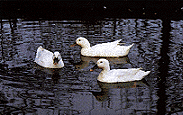 These ducks were bought from a leading commerciai hatchery and reared
by FAWN. From day one they displayed an intense interest in water and
now spend most of their waking hours swimming and investigating
streams and puddles. Photo: Chris James
These ducks were bought from a leading commerciai hatchery and reared
by FAWN. From day one they displayed an intense interest in water and
now spend most of their waking hours swimming and investigating
streams and puddles. Photo: Chris James
Ducks Are Big Business Too
Millions of ducklings are now 'factory farmed', to be killed at around eight
weeks of age. A leading duck producer recommends a space allowance of
five ducks per m2, while the Ministry of Agricultur(MAFF) suggests seven
ducklings per m2 on solid floor and eight on slats/wire. in practice a mixture
of both systems (straw or wood shavings, and wire) is common.
The MAAF welfare code for ducks advises:
'The system employed should be appropriate to the health and
behavioural needs of the ducks.'
'... wire floor rearing and fattening has much to commend it'
and
'water for swimming is not necessary'.
Diseases
Major causes of duck mortality include bacterial infections such as E. Coli
septicaemia and streptococcal septicaemia, and viral infections.
Cardiovascular disease also takes its toll, a result of stress and fast growth.
In the crowded conditions, ducks can be knocked over and 'stranded' on
their backs, and may be left to struggle for long hours in a vain attempt to
right themselves.
The Parent Stock
The breeders' deprivation is longer-lasting, and therefore more extreme.
Intensively-reared breeders are kept (usually at a ratio of one male to five
females) with shallow drinking troughs as the ironly source of water. Sheds
often contain up to 4,000 birds. For these adult birds MAFF suggests five
ducks per mZ on wire floors and three per m2 on solid floors. Optimum
fertility is promoted via lighting regimes and genetic selection. The birds
are regarded as mere
machines, to produce the
sperm/eggs for the meat
market. Anyone who has
observed with understanding the lively and
complex behaviour of
ducks in their natural environment will agree that
the supermarket' duck
and its parents lead a
barren existence.
Catching, Transport and Slaughter
Ducks are the Cinderella
of factory-farmed poultry.
Little is known about their suffering.